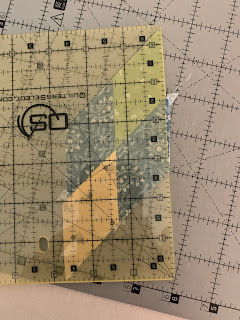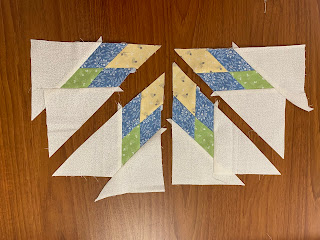As usual, I have lots to do. Last week I taught Oh My Stars! to 19 students locally. Some flew in, some drove a long distance, some were locals. It was great "practice" for me as I will be teaching this in Houston to 25 "strangers"--those not yet friends.
At my Retreat in March I taught this to 15, so this wasn't the first class presentation. Each class teaches me something, how to improve the way I present the class instruction. And for this class I wrote a 10 page "Addendum" to the pattern.
The students did great. Let's start at the end, with the "class photo":
It was especially great to have a friend come from Mobile to take the class, fellow quilt teacher Nina Clotfelter. She provided a chance to critique how class went and added helpful insights, even during class. And she made a great star:
All the students work, toward the end of the two-day, 10 hour class:
After class I made a couple "step outs" that will visually help students understand how to select and cut and sew the 5 fabrics needed for a star. I sent this to the class and they all agreed this visual will help understand the instructions:
The next time I teach this will be in Houston. That class filled in less than 30 minutes when enrollment opened and has a Waitlist. I am teaching it at
EMPTY SPOOLS SEMINARS April 29-May 4, 2026. And a Colorado guild has selected it for a class in June 2026. I love teaching this class and hope to get a few more opportunities.
After class Nina came to my home and while in the studio looking at my completed Laurel Ridge quilt top on the design wall, she noticed "something". Oh, NO! Upon careful study we found I had turned one section completely around. And it had to be fixed, since it's still a top:
Then, as if that wasn't enough, during my LIVE broadcast a few days later, someone with a good eye found 3 more blocks turned askew. Yes, they too have to be fixed. This is going to take some time. Even "professionals" make mistakes. Big Sigh...
The next project looms. In September I am teaching on two cruises, back to back. 10 days to New England and Canada followed by 5 days to Bermuda. The quilt for the New England/Canada cruise is On the Lily Pond, my own design, and the quilt is totally finished:
The other day I received the Kit for this project and have to "check" it. This means counting every piece to be sure they are all there and that all the needed pieces have been provided. This is going to take some time.
I love the fabrics selected and having them pre-cut will make this a breeze to sew. At least I don't have to make this top before we sail, just get Step-outs ready for teaching:
The Bermuda class project is much smaller, since it's a 5 day cruise. And that top I do have to complete before we sail. The Kit for it came this week so it had to be checked. There was an issue with one of the required shapes so they will be recut. And I am hard at work on the sample:
Only 10 more blocks to go:
Next up is pack for a teaching trip to the Eastern Shore of Maryland with the Bayside Quilters. One lecture, a half day class and a full day class will keep me busy. Then I am taking a side trip to Philadelphia to see friends and family. That will be fun.
I hope you are busy too!
Let's quilt.



















































